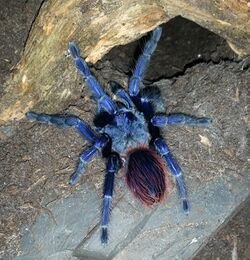Biology:Lasiocyano
| Lasiocyano | |
|---|---|

| |
| Scientific classification | |
| Domain: | Eukaryota |
| Kingdom: | Animalia |
| Phylum: | Arthropoda |
| Subphylum: | Chelicerata |
| Class: | Arachnida |
| Order: | Araneae |
| Infraorder: | Mygalomorphae |
| Family: | Theraphosidae |
| Genus: | Lasiocyano Galleti-Lima, Hamilton, Borges & Guadanucci, 2023[2] |
| Species: | L. sazimai
|
| Binomial name | |
| Lasiocyano sazimai (Bertani, Nagahama & Fukushima, 2011)[1]
| |
| Synonyms[1] | |
|
Pterinopelma sazimai Bertani, Nagahama & Fukushima, 2011 | |
Lasiocyano is a genus of tarantulas (family Theraphosidae).[2] (As of June 2023), it was a monotypic genus with the sole species Lasiocyano sazimai,[3] synonym Pterinopelma sazimai,[1] known as the Brazilian blue, iridescent blue or Sazima's tarantula. The species was first described by Rogério Bertani, Roberto Hiroaki Nagahama and Caroline Sayuri Fukushima in 2011.[1][4] In 2012, it became the first Brazilian species to appear on the International Institute for Species Exploration's top 10 new species list.[5] The species name honors Ivan Sazima, a Brazilian zoologist who was the first to collect exemplars of the species. It is now considered an endangered species owing to smuggling and a shrinking habitat.
Description
The life expectancy of Lasiocyano sazimai is not known.[6] All of its body is iridescent blue in color, with the exception of the opisthosoma, which may be blue covered in reddish hairs, though some lack this reddish hairs. The tarantula may also be darker or brighter in color, depending on several factors.
Habitat
Lasiocyano sazimai is native to an ecological island within the Chapada Diamantina National Park in Bahia, Brazil .[6] It has average temperaturs of 20 °C, with yearly precipitation being an average of 1000mm.[7] It is home to plants such as bromeliads, orchids, and animals such as ocelots, Rock cavies, and Teius teyou.[8]
Behavior
Lasiocyano sazimai spiders are opportunistic burrowers, though they spend most of their time in said burrows. If bothered they will bolt to their burrows, though if this is not possible, they will not hesitate to throw urticating hairs, or make a threat pose.[6]
References
- ↑ 1.0 1.1 1.2 1.3 "Taxon details Lasiocyano sazimai (Bertani, Nagahama & Fukushima, 2011)". World Spider Catalog. Natural History Museum Bern. http://www.wsc.nmbe.ch/species/37866.
- ↑ 2.0 2.1 "Gen. Lasiocyano Galleti-Lima, Hamilton, Borges & Guadanucci, 2023", World Spider Catalog (Natural History Museum Bern), https://www.wsc.nmbe.ch/genus/6453, retrieved 19 June 2023
- ↑ "Species list for Lasiocyano", World Spider Catalog (Natural History Museum Bern), https://www.wsc.nmbe.ch/specieslist/6453, retrieved 19 June 2023
- ↑ Rogério Bertani, Roberto Hiroaki Nagahama & Caroline Sayuri Fukushima (2011). "Revalidation of Pterinopelma Pocock 1901 with description of a new species and the female of Pterinopelma vitiosum (Keyserling 1891) (Araneae: Theraphosidae: Theraphosinae)" (PDF full text). Zootaxa 2814: 1–18. doi:10.11646/zootaxa.2814.1.1. http://www.mapress.com/zootaxa/2011/f/zt02814p018.pdf. Retrieved 28 May 2014.
- ↑ Institute for Species Exploration. "Top 10 New Species - 2012". Arizona State University. http://species.asu.edu/Top10.
- ↑ 6.0 6.1 6.2 "Pterinopelma sazimai" (in en-US). https://www.thetarantulacollective.com/caresheets/pterinopelma-sazimai.
- ↑ "Parque nacional de la Chapada de la Diamantina, Brasil: Tiempo y clima" (in es). https://geotsy.com/es/brasil/parque-nacional-de-la-chapada-de-la-diamantina-44436/tiempo-y-clima.
- ↑ "El Parque Nacional de la Chapada Diamantina. | Guia sobre Brasil" (in es). 2015-08-21. https://guiasobrebrasil.com/el-parque-nacional-de-la-chapada-diamantina/.
Wikidata ☰ {{{from}}} entry
 |

